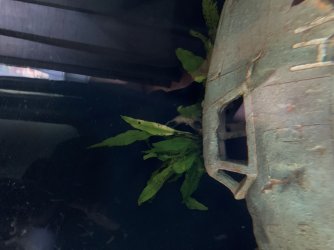Hi Below in bold:Slow down here, and back up.
First, there is absolutely nothing wrong with a low pH, neither your plants nor Tiger Barbs will have pH issues.
Nitrite...are you certain of the test result being 2 ppm? I doubt this is possible, or the barbs would be at the surface gasping if not floating dead.
Algae...do not get a fish to deal with algae. First, you need to identify the algae, which will tell you/us what is causing it. Normal algae especially in new tanks is not a problem as the biological system has not yet established and stabilized. Problem algae has a root cause and only resolving that will deal with it in planted tanks. For the moment, ignore the algae.
GH...I see no mention of the GH in this thread. Do you know the GH of your source (tap) water? With a lowish pH I assume it is going to be low, but let's confirm. No point in having surprises down the road because we didn't check.
Light...I recommended previously to reduce the lighting period each day, and use a timer so it is consistent. Has that been done?
Fertilizer...this was mentioned but I can't see a follow-up that identified what is being used. Can you tell us the fertilizer(s) and how much?
First, there is absolutely nothing wrong with a low pH, neither your plants nor Tiger Barbs will have pH issues.
Agreed. although I will try and raise it slightly to around 6 with a few pieces of crushed coral in the tank its self. nothing drastic.
Nitrite...are you certain of the test result being 2 ppm? I doubt this is possible, or the barbs would be at the surface gasping if not floating dead.
All fish fine acting normal. See image below. The 2 is what the color came out at and the nitrate 25. Could that be 0.2? Got liquid test kit on order However i didnt think it was possible in this planted tank at this PH?
Algae...do not get a fish to deal with algae. First, you need to identify the algae, which will tell you/us what is causing it. Normal algae especially in new tanks is not a problem as the biological system has not yet established and stabilized. Problem algae has a root cause and only resolving that will deal with it in planted tanks. For the moment, ignore the algae.
Why would the brown algae be forming? To much light, its a LED full spectrum light on for about 10-12 hours per day on a timer. I did ad fertiliser for the plants which worked.
GH...I see no mention of the GH in this thread. Do you know the GH of your source (tap) water? With a lowish pH I assume it is going to be low, but let's confirm. No point in having surprises down the road because we didn't check.
GH is 6<7 <125 on the image below.
Light...I recommended previously to reduce the lighting period each day, and use a timer so it is consistent. Has that been done?
I think the algae was the light, have it on 10-12 hours per day currently and that combined with the fertiliser(below)
Fertilizer...this was mentioned but I can't see a follow-up that identified what is being used. Can you tell us the fertilizer(s) and how much?
Tropica Premium Nutrition - stated dose for Literes. 2ml x10.



